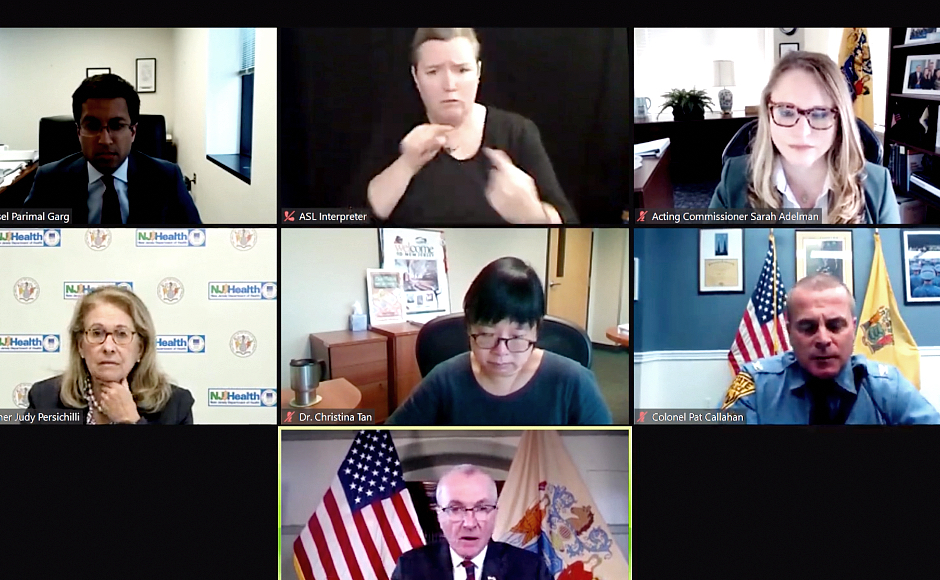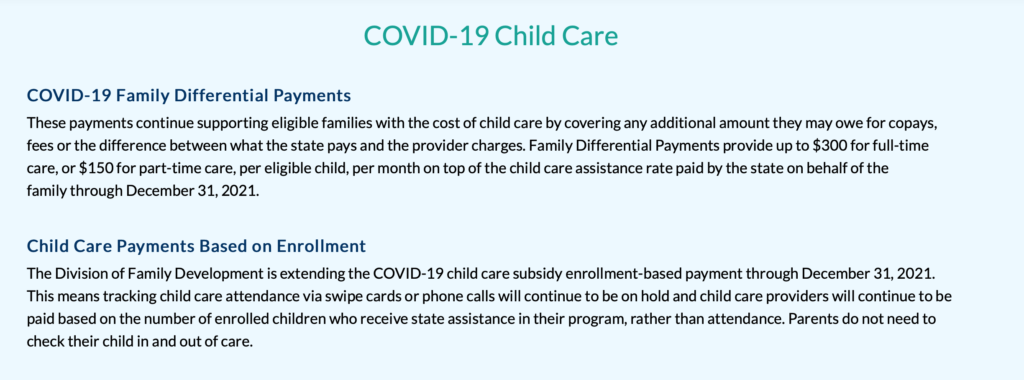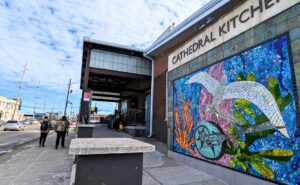The infusion of cash will help child care facilities to extend their hours, hire staff, and defray pandemic-related costs. It will also support parents’ out-of-pocket costs and summer camps.
By Matt Skoufalos | October 13, 2021
Another 1,366 New Jersey residents have tested positive for novel coronavirus (COVID-19), bringing the statewide total to 1.021 million cases confirmed via polymerase chain reaction (PCR) testing, Governor Phil Murphy reported Wednesday.
New Jersey is also reporting 472 new COVID-probable cases based on antigen tests, bringing the statewide total to 154,643 positive antigen tests.
Antigen tests have a faster turnaround time than PCR tests—sometime within 15 to 30 minutes—but are less reliable at detecting active infection of the virus, and more capable of reporting false positives.
Sadly, 29 more residents have perished from complications related to the virus, bringing the statewide, confirmed death toll to 24,850 lives lost during the pandemic.
In addition to those lab-confirmed fatalities, the state has acknowledged another 2,803 probable COVID-19-related deaths—six more than previously reported.
Since March 2020, 1,054 of every 100,000 New Jersey residents have been hospitalized with COVID-19, and 283 of every 100,000 have died from COVID-19-related complications.
More than 15.724 million polymerase chain reaction (PCR) tests for COVID-19 have been performed statewide, with a 11.616-percent positivity rate per 100,000 residents.
Rate of transmission (Rt) at 0.94, spot positivity highest in South Jersey
The statewide average of COVID-19 spot positivity testing based on PCR test results stood at 5.72 percent October 9; in South Jersey, it was highest, at 7.77 percent.
Rt, the variable that describes the seven-day, rolling-average, statewide rate of transmission of new COVID-19 cases, hit 0.94 on October 13.
Any Rt figure less than 1.0 means that each new COVID-19 patient is infecting fewer than one other person, on average, and the spread of the virus is decreasing.
Since its mid-April-2020 COVID-19 spike, the highest reported RT in New Jersey was 1.48, recorded August 1, 2020. Prior to artificially low, adjusted reports of 0.34 in the first week of May, the lowest in the past year was 0.62, recorded June 9, 2020. On May 21, 2021, it reached a new low, of 0.59.
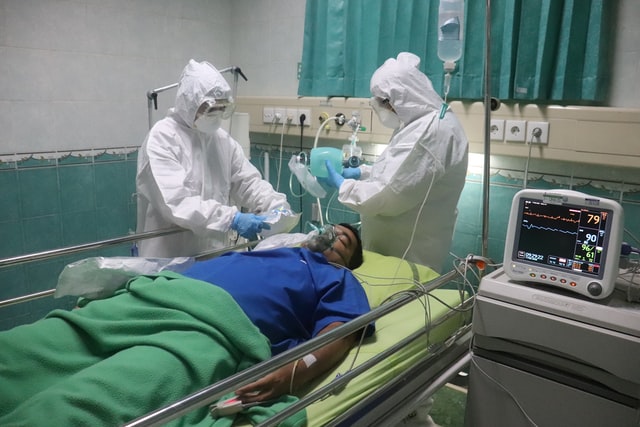
Simulated COVID-19 patient in a hospital bed. Photo by Mufid Majnun on Unsplash
COVID Hospitalizations below 1,000
Throughout New Jersey, 895 people currently are hospitalized with a suspected (66) or confirmed (829) case of COVID-19, Murphy said.
Among those hospitalized patients, 219 are in intensive or critical care, and 117 of the ICU and critical-care patients (53 percent) are on ventilators.
In New Jersey’s 71 critical care hospitals, 113 patients were hospitalized with COVID-19 yesterday, while 117 others were discharged.
LTC update
Across the state, long-term care (LTC) centers have reported 1,765 cumulative outbreaks of COVID-19, and 167 are dealing with an active outbreak. LTCs account for 56,963 infected patients and staff in New Jersey, or 5.7 percent of total cases.
That includes 33,836 residents and 23,127 staffers sickened by the virus, as well as 8,573 lab-confirmed resident and staff deaths (35 percent of the statewide confirmed total), with facilities self-reporting 146 staff deaths.
Of 653 veterans residing in three state-run homes, 456 residents have tested positive for COVID-19, and 157 have died from complications related to the virus. Three hundred veterans have recovered from the virus. Six residents currently are COVID-19-positive.
The facilities at Menlo Park, Paramus, and Vineland are staffed by 1,371 workers, four of whom are presently COVID-19-positive. The facilities have sustained two staff deaths related to the virus.
At state-run psychiatric hospitals, 374 of 1,135 patients and 1,136 staff members have tested positive for COVID-19. Fourteen patients and eight staffers have died from complications related to the virus.
MISC cases and schools
To date, 133 New Jersey children aged 1 to 18 have been diagnosed with pediatric multisystem inflammatory syndrome (MISC). Four of those cases were reported in Camden County, tied with Cumberland and Monmouth Counties for third-least in the state.
All those pediatric patients have tested positive for an active COVID-19 infection or the presence of COVID-19 antibodies, indicating exposure to the virus. No deaths have been associated with this syndrome in New Jersey, although several children have been hospitalized during their treatment for the illness.
From August 1, 2020 through the end of the 2020-2021 school year, 293 COVID-19 outbreaks encompassing 1,385 individual cases were traced to in-school activities in all 21 New Jersey counties. In Camden County, 18 outbreaks were linked to 78 in-school cases, sixth-most in the state.
Since the start of the 2021-2022 school year, 96 reported outbreaks—three or more students or staff who contracted the virus within the school—have been logged, affecting 521 people, a mix of students (444) and staff (77).
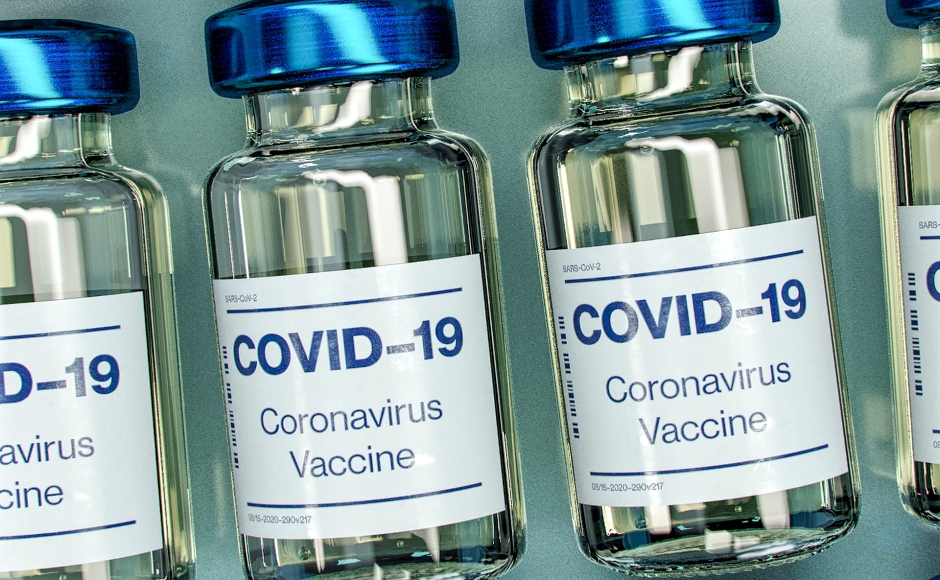
COVID-19 vaccine bottle mock-up. Photo by Daniel Schludi on Unsplash
Vaccination update: NJ approaches 6M fully vaccinated people, exceeds 11M doses administered
Across New Jersey, 11.972 million COVID-19 inoculations have been administered.
Throughout New Jersey, 5.752 million people have been fully vaccinated in-state, having received either a one-shot formulation from Johnson and Johnson or both doses of the two-shot Pfizer or Moderna vaccines.
In Camden County, 639,965 doses have been administered, seventh-most in the state; 309,064 people have been fully vaccinated.
An estimated 451,366 vaccine doses have been administered to New Jersey residents outside of the state, of which 193,532 residents are estimated to have been fully vaccinated.
The first vaccines in the state were administered December 15, 2020; by February 8—55 days later—New Jersey had immunized its millionth resident. Twenty days thereafter, that count hit 2 million, and 3 million within two more weeks.
On March 29, New Jersey crossed the 4-million-dose threshold, and the state cleared 5 million doses over the weekend of April 10, 2021. Eight days after that, New Jersey hit the 6-million-dose mark. By May 3, 2021, the state had cleared 7 million doses administered, and two weeks later, it had surpassed 8 million doses.
As of June 2, 2021, the state had cleared 9 million administered doses and 4 million fully vaccinated New Jerseyans, and on June 18, hit 4.7 million vaccinated individuals, its target goal for 70 percent of the adult population of the state.
By mid-July, that number had increased to 5.019 people fully vaccinated at New Jersey vaccination sites. By the end of August 2021, the state had exceeded 11 million doses administered and had begun approaching 6 million fully vaccinated residents.
Breakthrough case data, January 19 through September 27, 2021
The data on breakthrough infections—circumstances in which fully vaccinated people test positive for COVID-19—continues to show the effectiveness in the vaccine preventing serious infection and death.
In the last nine months, 5.571 million New Jersey residents have been fully vaccinated against COVID-19 (January 19 through September 27). Of that population, 33,963 tested positive for COVID-19 after having been vaccinated (0.61 percent).
In that same timeframe, 672 fully vaccinated people required hospitalization for the virus, and 182 died of COVID-19-related causes.
NJ dedicates $700M to childcare through 2023
Murphy announced Wednesday that the state will invest $700 million in American Rescue Plan (ARP) funds into child care services through the end of 2023 to help support working families and the providers who care for their children.
For parents, the additional dollars will be dedicated to relieving the costs of child care services in the form of Family Differential Payments and waiving New Jersey child care subsidy co-payments. Eligible families can receive as much as $300 per child, per month, for full-time care, or $150 for part-time care. These benefits will supplement the child care assistance such families already receive through December 2023.
For child care providers, the funding can incentivize staff recruitment and retention via a $1,000-per-employee bonus payable in winter 2021 and another in summer 2022.
State-licensed child care centers also will be eligible for two new rounds of pandemic stabilization grants based upon the number of children served in their facilities. For these centers, $20,000 to $80,000 available in the first round; family child care providers can receive $2,000 awards.
That money is earmarked for “operating expenses such as wages and benefits, rent and utilities, cleaning and sanitizing, facilities maintenance, and improvements.”
Finally, additional ARP-funded grants will also be used to support summer youth camp providers in covering “COVID-related costs,” as well as helping families pay for camp.
Sarah Adelman, Acting Commissioner of the New Jersey Department of Human Services, said the dollars would “stabilize providers facing closure and fluctuating attendance,” and incentivize expanded hours for nights and weekends.
Reducing the out-of-pocket costs of child care will be especially meaningful to working mothers, “who have been disproportionately impacted by the pandemic,” Adelman said.
The investment in child care services is part of a $1-billion total allocation “after a decade of no increases,” she said.
“We know that childcare is one of the key challenges facing families, especially single moms, as they re-enter our workforce,” the governor said. “High-quality childcare is good for both our kids and their parents.”
“Childcare is a game-changer,” he said. “It’s money to help families afford it; money to the childcare centers to help them.”

